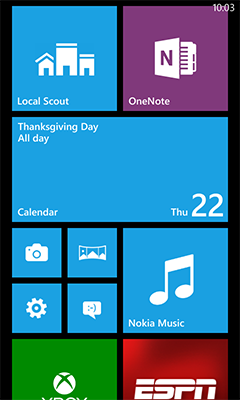Windows Phone 8
| A version of the Windows Phone operating system | |

Windows Phone 8 Start Screen
|
|
| Developer | Microsoft Corporation |
|---|---|
| Written in | C++ |
| Source model | Closed-source |
| General availability |
October 29, 2012 |
| Latest release | Update 3 (Build 8.0.10532.166) / April 14, 2014 |
| Update method | Firmware over the air |
| Platforms | 32-bit ARM architecture |
| Kernel type | Hybrid (NT kernel) |
| License | Commercial proprietary software |
| Preceded by | Windows Phone 7 (2010) |
| Succeeded by | Windows Phone 8.1 (2014) |
| Official website | Archived official website at the Wayback Machine (archive index) |
| Support status | |
| Unsupported as of January 12, 2016 Upgrading to the latest Windows Phone/Mobile version by the carrier or manufacturer is required for Windows Phone 8 users to continue to receive support. |
|
Windows Phone 8 is the second generation of the Windows Phone mobile operating system from Microsoft. It was released on October 29, 2012, and like its predecessor, it features a flat user interface based on Metro design language. It was succeeded by Windows Phone 8.1, which was unveiled on April 2, 2014.
Windows Phone 8 replaces the Windows CE-based architecture used in Windows Phone 7 with the Windows NT kernel found in Windows 8. Current Windows Phone 7 devices cannot run or update to Windows Phone 8 and new applications compiled specifically for Windows Phone 8 are not made available for Windows Phone 7 devices. Developers can make their apps available on both Windows Phone 7 and Windows Phone 8 devices by targeting both platforms via the proper SDKs in Visual Studio
Windows Phone 8 devices are manufactured by Microsoft Mobile (formerly Nokia), HTC, Samsung and Huawei.
On June 20, 2012, Microsoft unveiled Windows Phone 8 (codenamed Apollo), a third generation of the Windows Phone operating system for release later in 2012. Windows Phone 8 replaces its previously Windows CE-based architecture with one based on the Windows NT kernel, and shares many components with Windows 8, allowing developers to easily port applications between the two platforms.
Windows Phone 8 also allows devices with larger screens (the four confirmed sizes are "WVGA 800×480 15:9","WXGA 1280×768 15:9","720p 1280×720 16:9","1080p 1920x1080 16:9" resolutions) and multi-core processors, NFC (that can primarily be used to share content and perform payments), backwards compatibility with Windows Phone 7 apps, improved support for removable storage (that now functions more similarly to how such storage is handled on Windows and Android), a redesigned home screen incorporating resizable tiles across the entire screen, a new Wallet hub (to integrate NFC payments, coupon websites such as Groupon, and loyalty cards), and "first-class" integration of VoIP applications into the core functions of the OS. Additionally, Windows Phone 8 will include more features aimed at the enterprise market, such as device management, BitLocker encryption, and the ability to create a private Marketplace to distribute apps to employees—features expected to meet or exceed the enterprise capabilities of the previous Windows Mobile platform. Additionally, Windows Phone 8 will support over-the-air updates, and all Windows Phone 8 devices will receive software support for at least 36 months after their release.
...
Wikipedia
